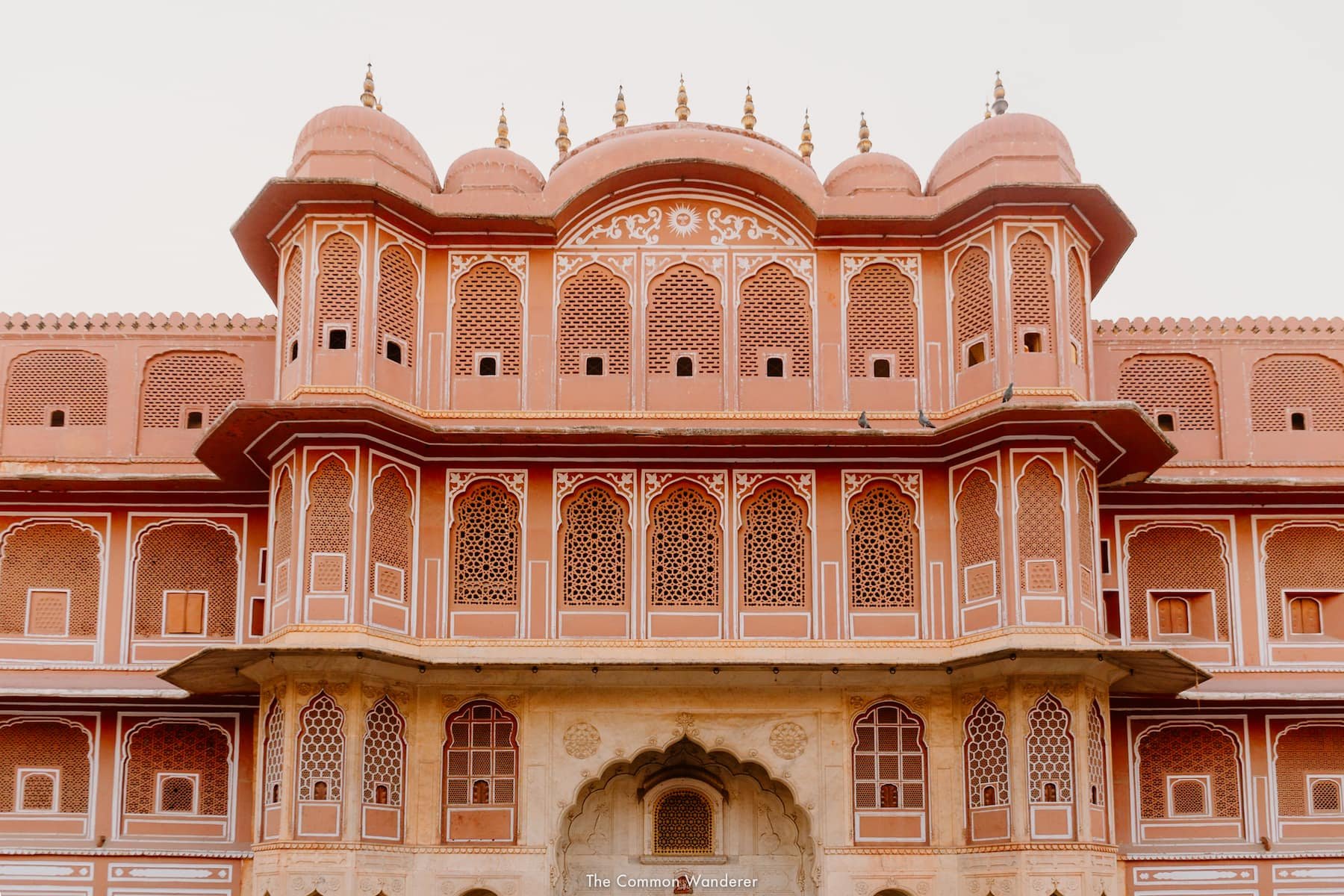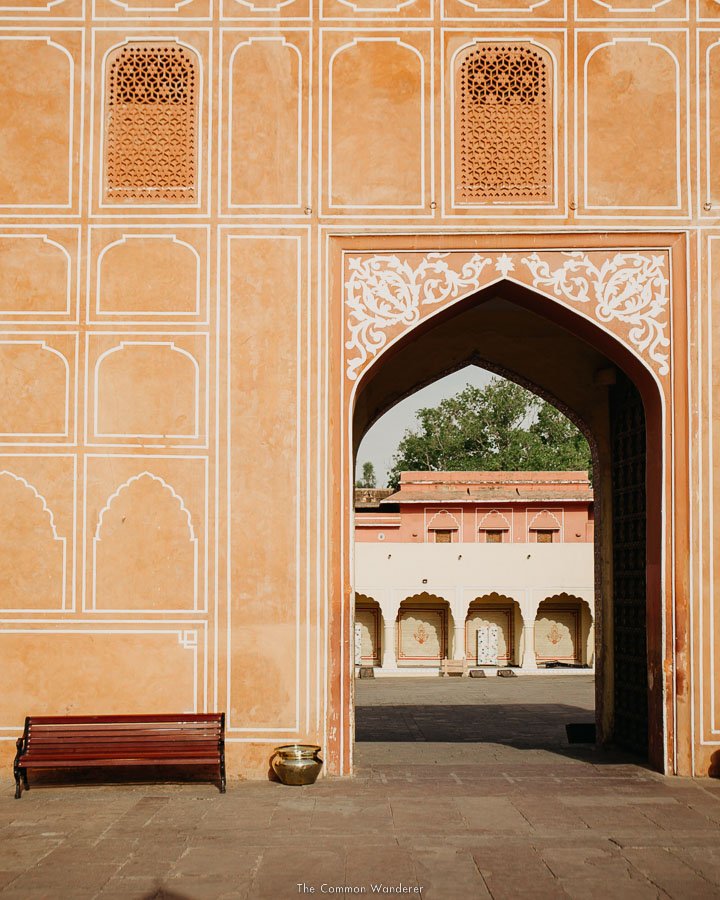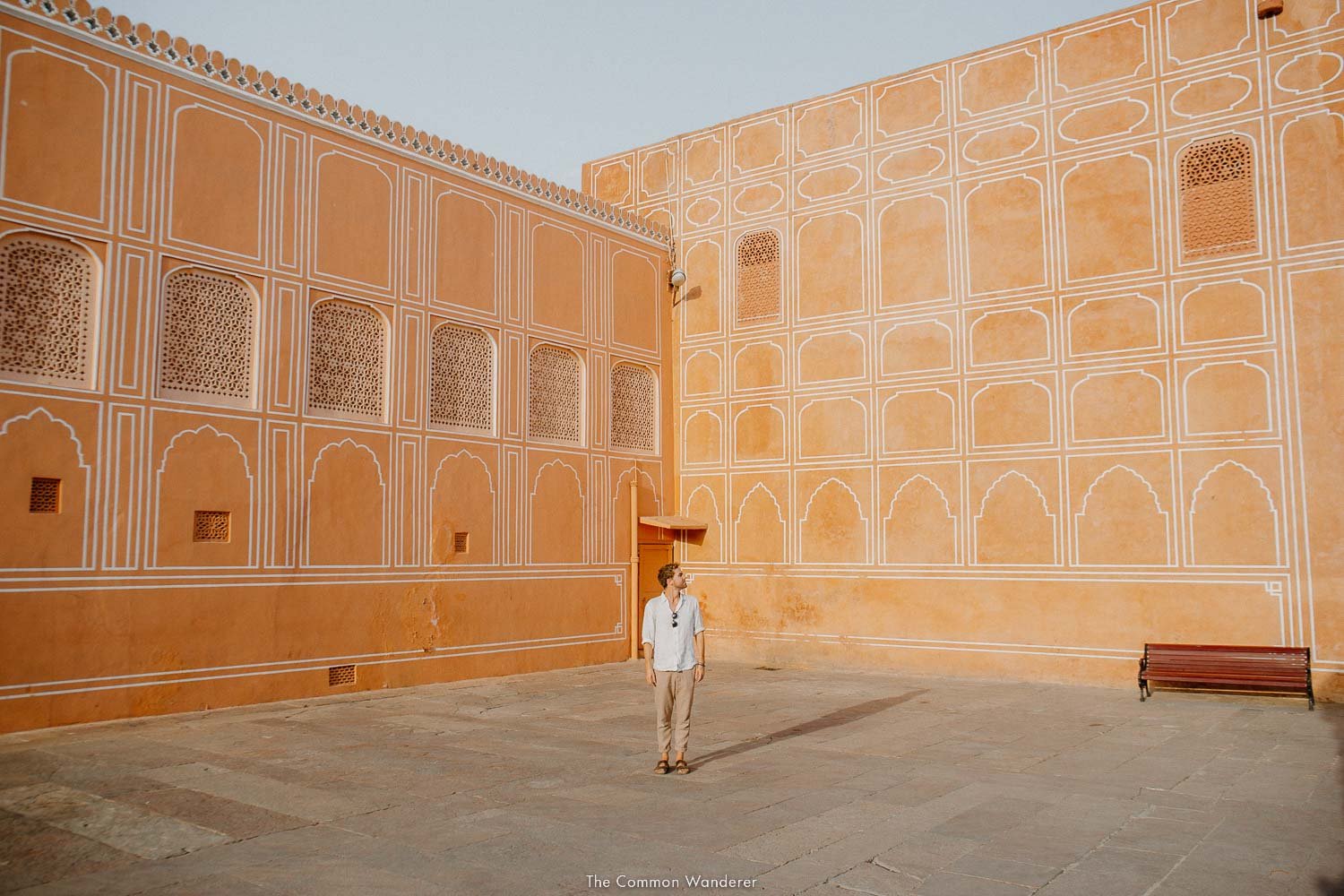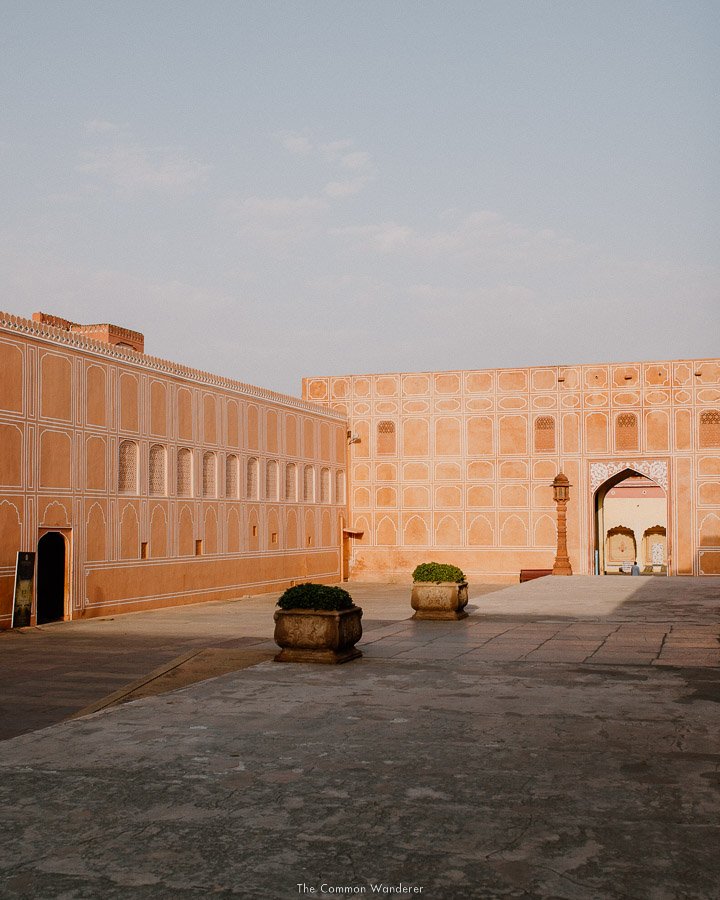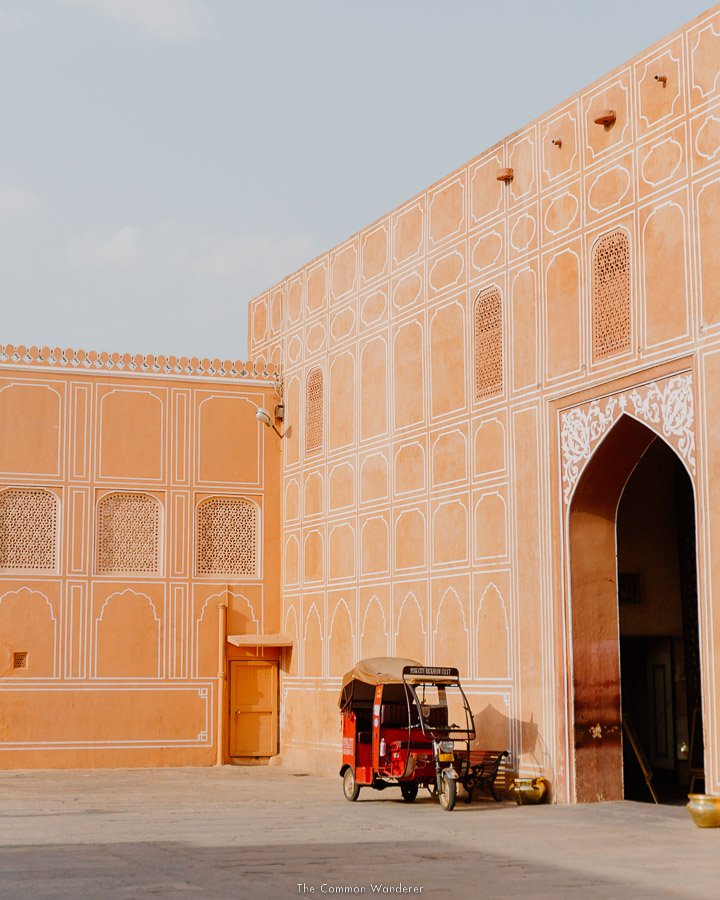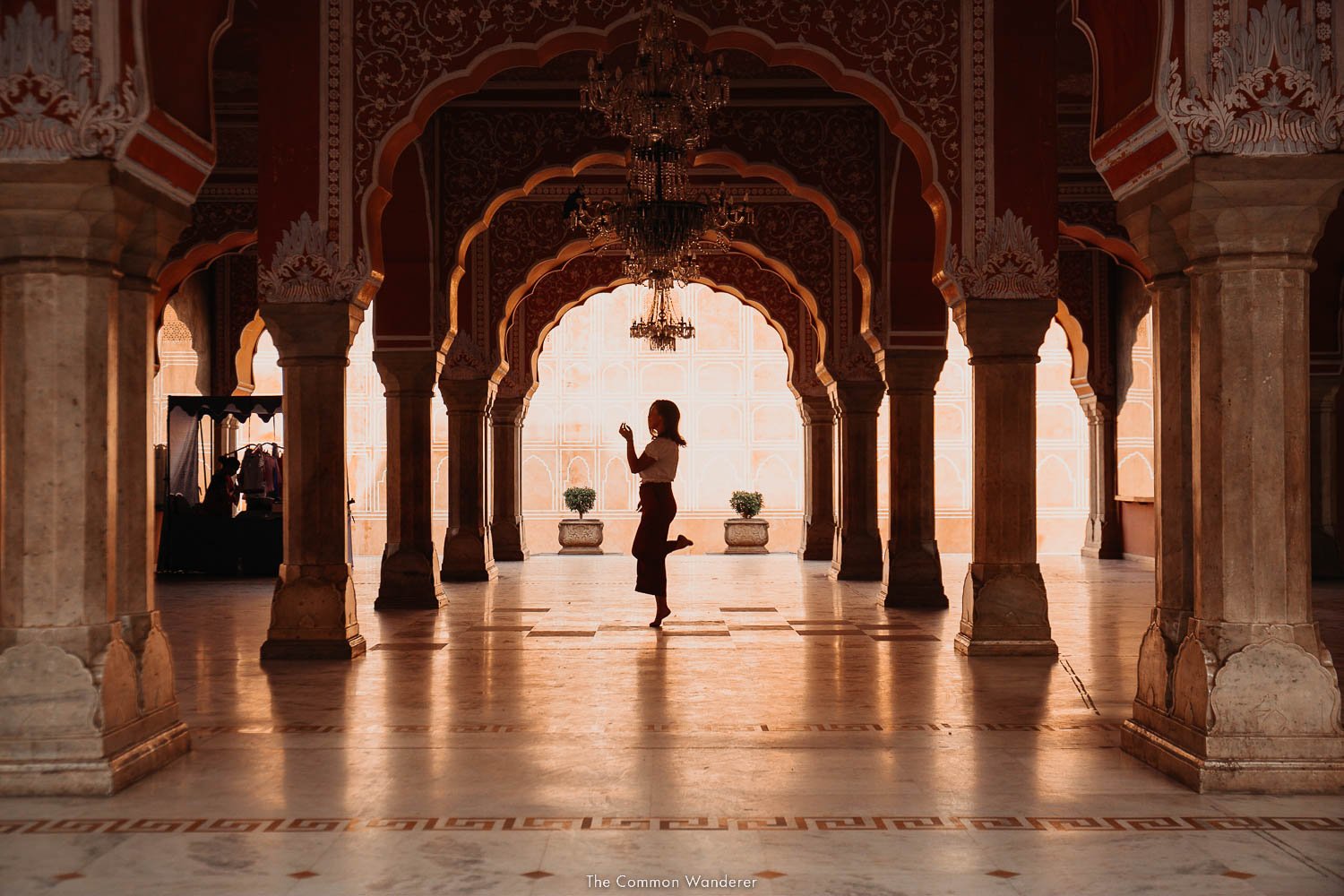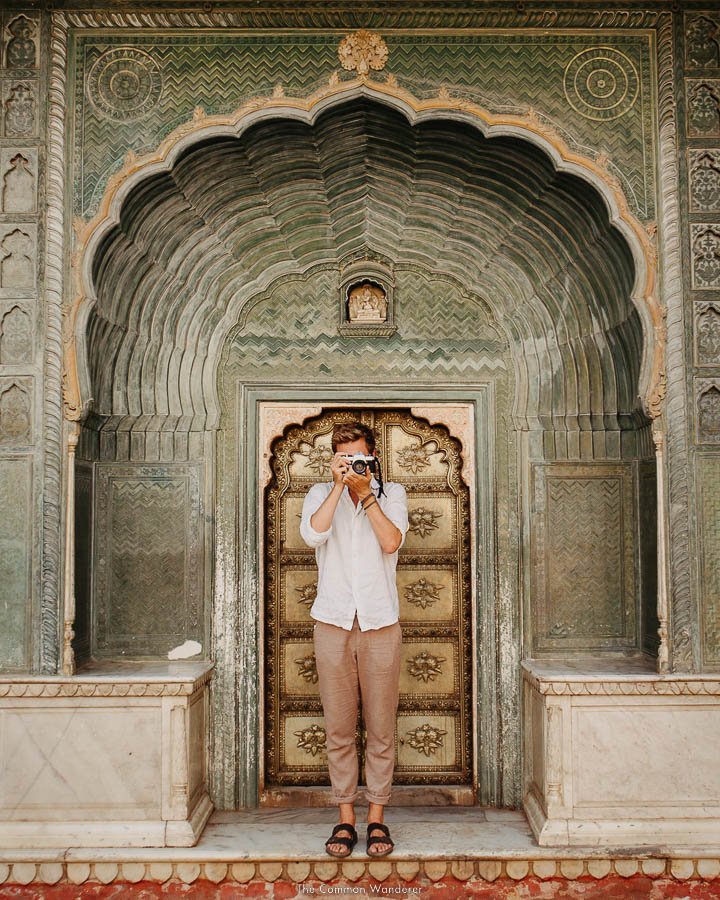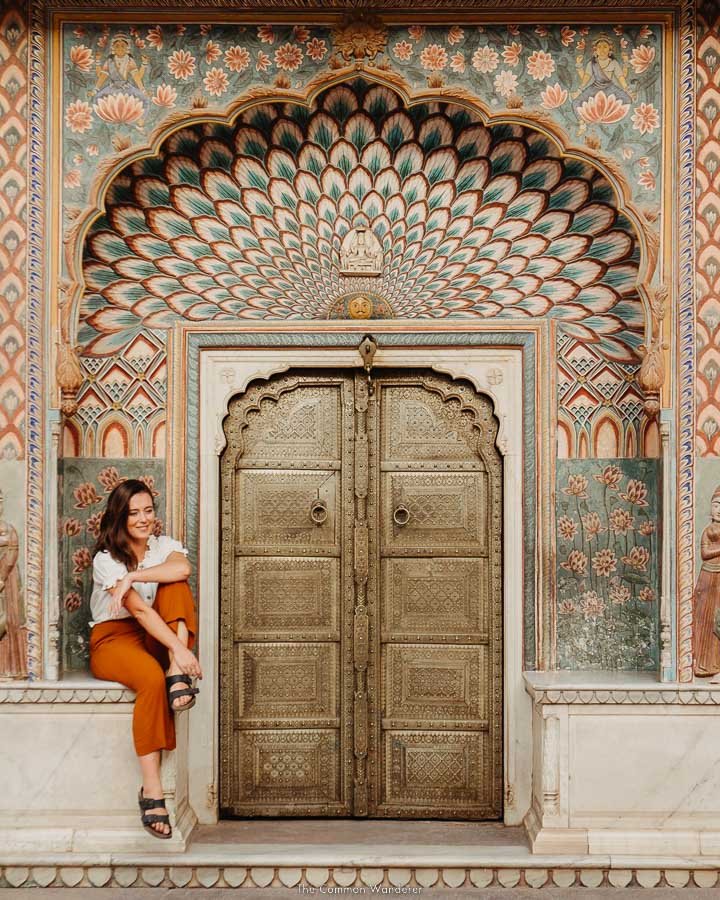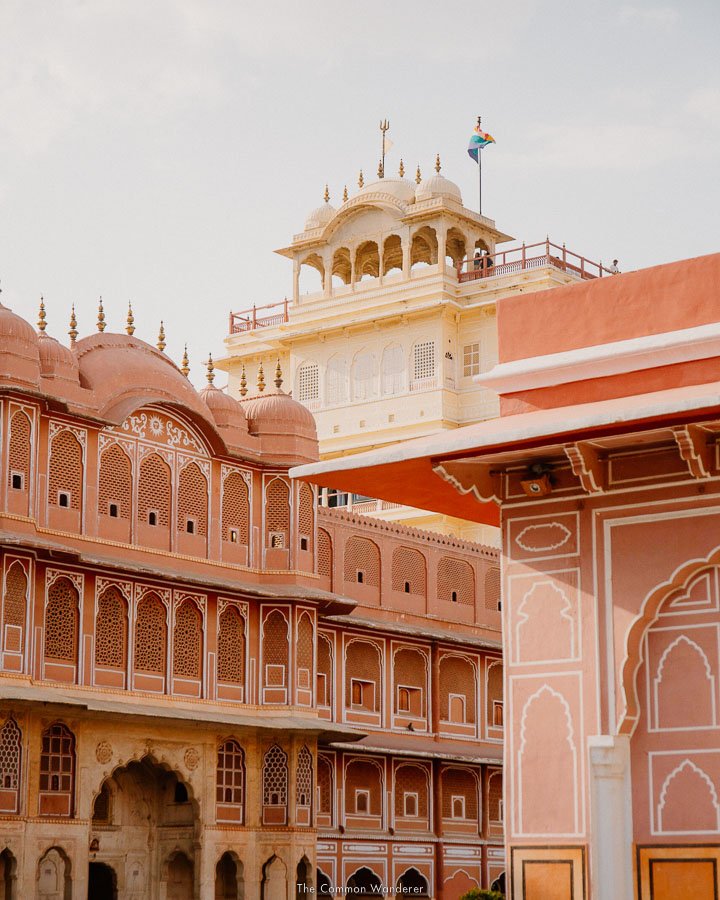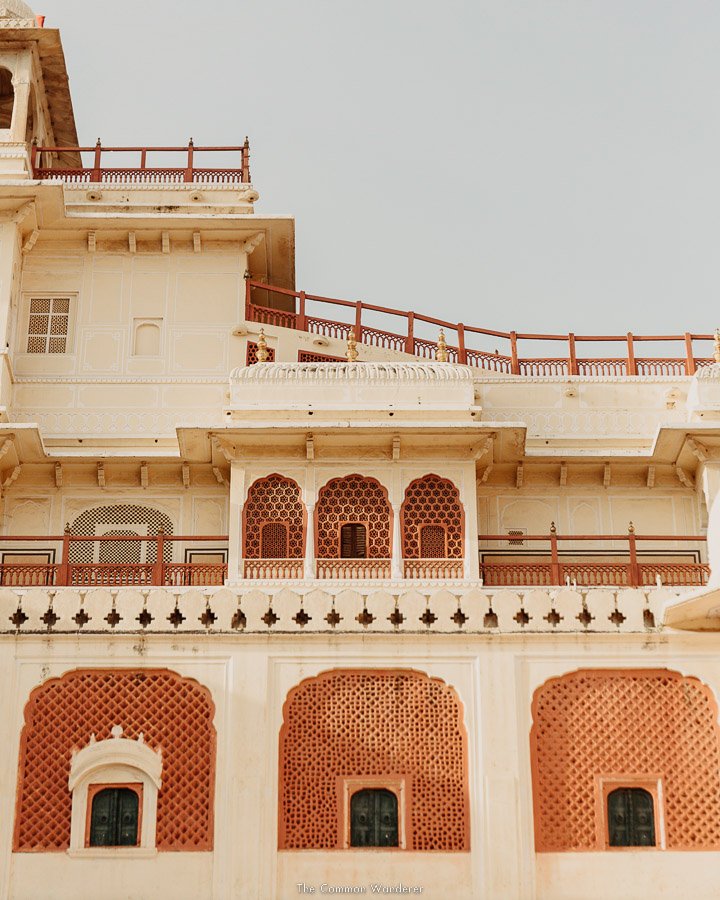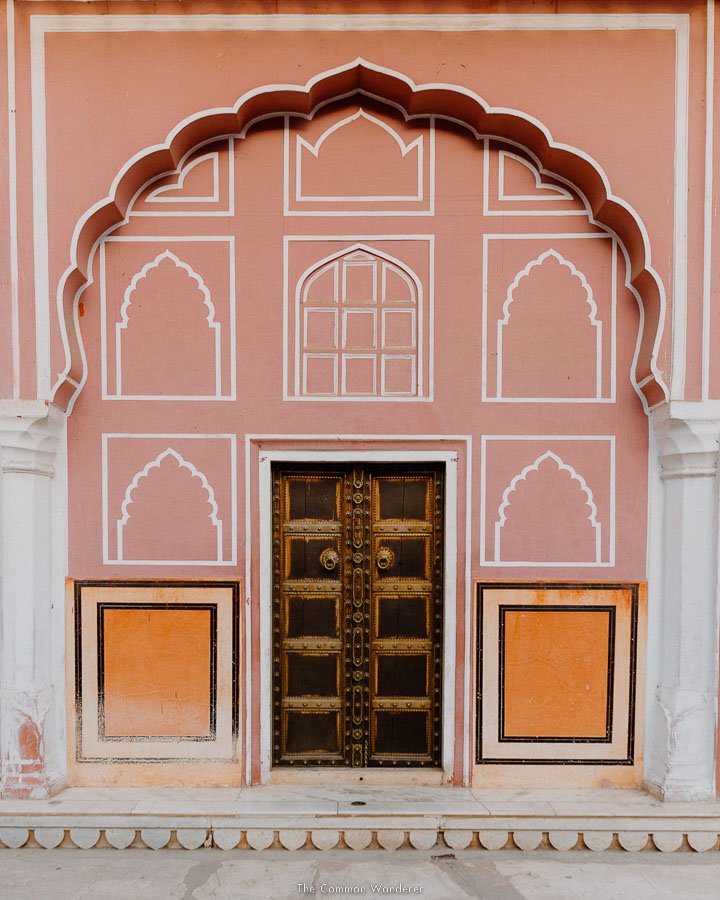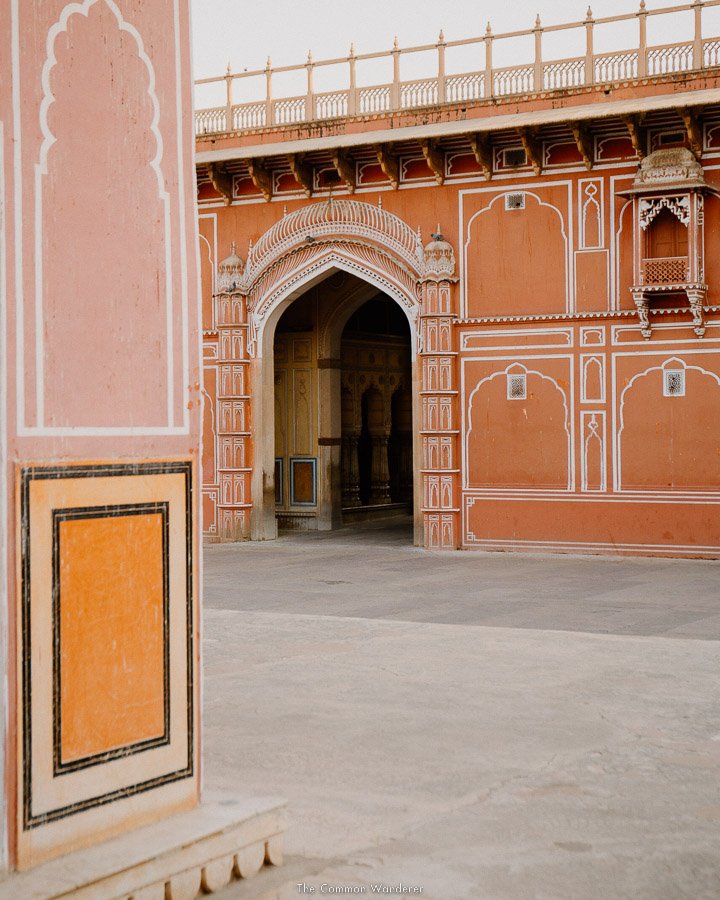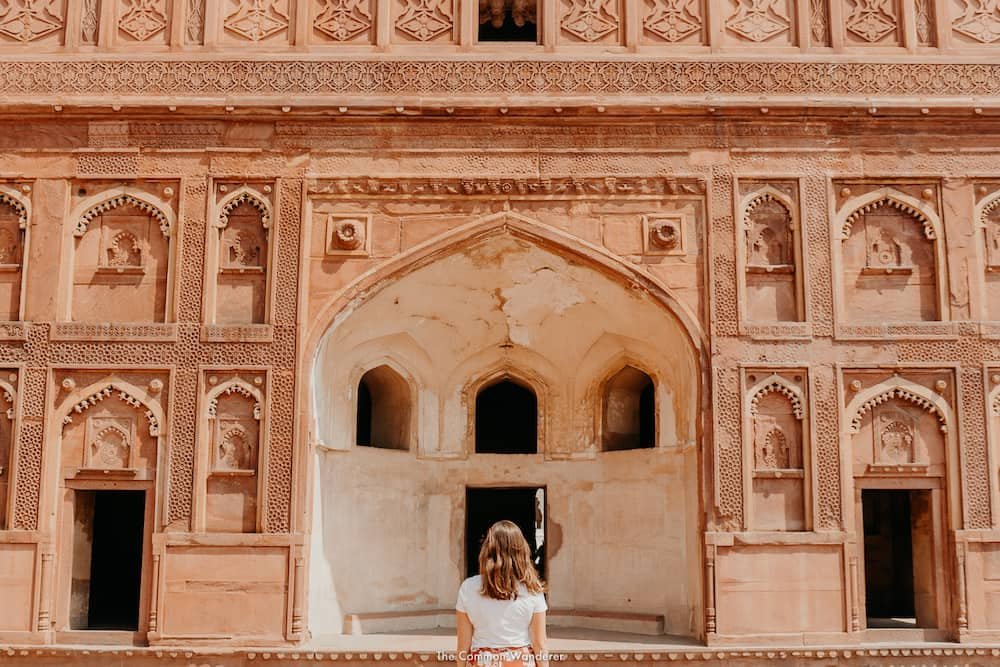A Detailed Guide to Jaipur’s Enchanting City Palace
Jaipur City Palace is a must-visit attraction in the ‘Pink City’.
This City Palace guide provides a detailed overview of the complex, including what to see, entry fees, the historical context, and essential planning information to help you enjoy the best experience possible.
Elegant, enchanting, and ornate; there are many ways to describe Jaipur’s City Palace, however, mesmerising sums it up perfectly.
Set in the heart of Jaipur’s walled Pink City, the City Palace is a showcase of opulent beauty and an aesthetically pleasing blend of some remarkable Rajput and Mughal architecture.
Every inch of this palace is mesmerising (like much of Jaipur, to be honest), made of red and pink sandstone, glistening white marble, antique artwork, intricate details and kaleidoscopic patterns.
City Palace features a charming seven-story citadel, antique museum, vast courtyards, luxurious rooms, perfectly manicured gardens and enchanting archways - all well-curated and built to perfection.
To this day, City Palace is home to the present royal family of Jaipur, where they exclusively reside inside the Chandra Mahal complex.
A colourful, regal wonderland, the most striking part of the City Palace of Jaipur is the iconic and oft-photographed Pritam Niwas Chowk, the globally recognised gates replete with artistic patterns and a kaleidoscope of colours.
If you’ve ever wanted to take a peek into the 18th-century tales of Jaipur’s royal family and their life once lived, without a doubt, you need to add Jaipur’s City Palace to the never-ending list of must-see attractions in Rajasthan.
This City Palace guide provides a detailed overview of the complex, including what to see, entry fees, the historical context, and essential planning information to help you enjoy the best experience possible.
LOVE OUR PHOTOS? Edit like us with our Indian Odyssey Preset Pack, and Tropical Bliss mobile video filters, inspired by the tropical beauty and colour of this beautiful country
JAIPUR CITY PALACE
SNAPSHOT
WHERE | City Palace, downtown Jaipur
HOW TO GET THERE | Bus, auto-rickshaw, walk, private tour
WHAT TO SEE | You can’t miss Mubarak Mahal, Rajendra Pol, Diwan-e-Khas, Chandra Mahal
TOURS | This popular City Palace, Hawa Mahal and Jantar Mantar guided tour, or this photography tour of Jaipur
BEST TIME TO VISIT | March - April, arrive early
HOW LONG SHOULD YOU SPEND? | 3+ hours to fully appreciate the Fort
A LITTLE HISTORY OF JAIPUR CITY PALACE
The grand City Palace of Jaipur was built between 1729 - 1732 under the rule of Maharaja Sawai Jai Singh, alongside the city of Jaipur.
The town of Amer and the majestic Amber Fort were once the capital and home to the reigning royal family, however, as the population grew and water became scarce, the Maharaja decided to discover a new capital, and boom, hand in hand the City Palace and city of Jaipur were born.
Two extremely talented architects were to thank for the lavish design of the palace; a Bengali gentleman named Vidhyadhar Bhattacharya, and a British sir named Samuel Swinton Jacob - the masterminds of the architectural marvels of both the City Palace and the entire city of Jaipur!
Fun fact: If you’ve ever wondered how Jaipur got its nickname the ‘Pink City,’ then you’ve come to the right place. Once upon a time, around the independence of India, King Edward VII (then Prince of Wales,) was due to visit India.
All in a bid to impress the Prince, Maharaja Sawai Jai Singh decided to give the city a bit of a spruce up and elaborately had the city completely painted in pink - how crazy is that!
BOOK | This popular City Palace, Hawa Mahal and Jantar Mantar guided tour, or this photography tour of Jaipur
WHAT TO SEE IN JAIPUR CITY PALACE
The City Palace complex is an extravagant complex with lots to see and do, so we’ve whittled down the must-see sights to help you enjoy the best visit possible.
MUBARAK MAHAL
As you enter through Virendra Pol and into the first courtyard, you’ll be greeted by a creamy, stand-alone haveli called Mubarak Mahal, meaning ‘welcome place’ - once the reception hall and also the last addition to the City Palace.
Decked with striking carvings, intricately designed arches and ornamental pillars, this building is one to cast your eyes on.
Today, Mubarak Mahal houses part of the Maharaja Sawai Man Singh II museum, showcasing an impressive collection of elaborate textiles belonging to the royals.
Silk sarees, embroidered shawls and ethereal dresses of the princesses are displayed ever so beautifully here.
However, the most impressive display is well and truly the wonderfully huge regal costume, once worn by Maharaja Sawai Madho Singh. Wildly he had 108 wives and trousers that were almost 1.2 meters wide.
Welcome to medieval India, ladies and gents!
Note | No photography is allowed inside the museum
RAJENDRA POL
To the right of Mubarak Mahal is an enchanting marble gateway, Rajendra Pol. Follow through this beauty to enter the main courtyard of Diwan - E - Khas, where the real show begins.
This isn’t any old gateway, though. The exterior shows off the tiniest of carvings, prettiest of balconies and grandest of brass-studded doors.
Two wonderfully sculpted marble elephants stand tall on either side of the pathway, and palace guards looking dapper carry charming white suits, traditional red turbans, and sport perfectly twisted mo’s.
Don’t be afraid to ask these kind sir’s for a friendly photo if you wish!
DIWAN - E - KHAS
When entering Diwan - E - Khas, it seriously feels like you’ve walked onto a set of some gorgeous romantic movie. From its dripping crystal chandeliers hanging ever so elegantly to the immaculate marble floors and luxurious red stone archways - this is a must-see.
The opulent pink pavilion perched in the middle of the courtyard is known as the king's hall of private audience. It still holds importance today as it was the hall where major religious rituals and festivals took place.
The drawcard to Diwan - E - Khas is the display of two large and legendary silver Gangajelies, or water urns, that back in the day carried two months’ worth of holy Ganga water for Maharaja Sawai Madho Singh, on his visit all the way to London.
These weigh 345 kgs when empty and are officially the biggest sterling silver urns in the world, according to the Guinness Book of Records.
PRITAM NIWAS CHOWK
Ridhi Sidhi Pol gate leads to an inner courtyard called Pritam Niwas Chowk, or ‘courtyard of the beloved,’ which is literally something from an Instagrammers wildest dreams.
As you enter this unique enclosed courtyard you’ll be greeted with four elaborate brass doors that are bound to catch your eye. Bursting with punchy colours and decked in bejewelled motifs, these gates are quite simply, picture-perfect.
Everyone flocks to this courtyard in Jaipur’s City Palace, so expect it to be crowded and teeming with photoshoots, but for a good reason.
The four gates symbolise each of the four seasons and honour the Hindu Gods - Lotus Gate: represents summer and is dedicated to Lord Shiva, Peacock Gate: Autumn and Lord Vishnu, Rose Gate: Winter and Goddess Devi, and Leheriya Gate: Spring and Lord Ganesha.
Pritam Niwas Chowk was originally used for royal dance performances during festive occasions, with dancers twirling in the courtyard below and singers performing on the balconies overhead.
Note | Please, respect your surroundings. We’ve heard some of these doors have been damaged by unruly tourists and their selfie sticks. As always, practice the responsible tourism mantra of leaving things better than you found them.
CHANDRA MAHAL | SUKH NIWAS / RANG MANDIR / SHOBHA NIWAS
Sprawling over seven levels, the lavish Chandra Mahal building, or ‘Moon Palace,’ features a collection of treasured private rooms and picturesque views over the Pink City of Jaipur. Part of the building is where the present royal family resides, and other parts happen to be private hotspots of Jaipur’s City Palace.
The first floor is where you’ll find the main part of the Maharaja Sawai Man Singh II museum, home to a rare collection of royal family artefacts. Everything from old weaponry, carpets and manuscripts, to blue pottery, block prints and antique Indian artwork.
A recognisable spot is the Sukh Niwas, commonly known as the ‘blue room,’ which is named after Maharaja Sawai Jai Singh’s wife. This room is a fully furnished royal dining room on the second floor, recognisably bright blue in colour with gorgeous white detailing.
The third and fourth floors are home to Rang Mandir ‘The Mirror Room,’ and Shobha Niwas ‘Hall of Beauty’ respectively. Check out these rooms to take in the amazing mirror work, embellished tiles and gold leaf detailing that graces every wall. So very fancy!
Chavi Niwas is on the fifth floor and used to be the Maharaja's resting place, while Shri Niwas covers the sixth.
Lastly, the seventh and top floor is called Mukut Niwas and is known as the crown of the palace. This is where the flags are hoisted into the sky, stating that the Maharaja is home, and where you can catch a glimpse over the city.
Note | The first-floor museum is the only part of Chandra Mahal that you can enter on a standard ticket. The upper rooms are hidden in a private part of City Palace and can only be visited when purchasing an additional ticket called ‘Royal Splendour’ (see information below). Be prepared to fork out extra if you wish to explore as the pricing is a tad bit hefty!
BOOK | This popular City Palace, Hawa Mahal and Jantar Mantar guided tour, or this photography tour of Jaipur
THINGS TO KNOW BEFORE VISITING JAIPUR CITY PALACE
CITY PALACE JAIPUR TICKET PRICE AND OPENING TIMES
Jaipur City Palace is open daily, between the hours of 9:30 am - 5 pm.
As of 2024, entry fees are INR 700 ($9 USD) per person for foreigners.
If you’d like to gain access to the upper floors of the palace, including the famous blue room, you’ll need to purchase the hefty Royal Splendour ticket, which is INR 3,500 per person ($43 USD).
The ticket includes access to the upper floors of Chandra Mahal, along with a private guide and a complimentary chai.
Further fees are listed below:
Photography Fee | INR 50. Note: Photography and videography use are charged additionally (no tripods allowed).
Videography Fee | INR 150
Audio Guides | INR 200. Information is clearly displayed throughout the complex, with well-written English signs next to the exhibits and rooms - so this isn’t necessary.
WHERE IS JAIPUR CITY PALACE, AND HOW TO ENTER
Located right in the heart of downtown Old Jaipur, the City Palace is super easy to reach from anywhere in the city.
The Palace is easily accessible by auto-rickshaw, taxi or cycle rickshaw, or Metro (get off at Badi Chaupar station).
The entry is through one of three main, wonderfully ornate gates: Udai Pol, Virendra Pol, or Tripolia - the latter used solely by the royal family.
Note | Technically, the palace includes the Hawa Mahal and Jantar Mantar, however, as each one is given its own entrance, they are considered three separate attractions.
TO HIRE A GUIDE, OR NOT?
When we visited Jaipur City Palace we decided to take our time and explore the ornate complex on our own, and while this was wonderful and allowed us time to explore at our own pace, we missed the historical and cultural overview of the Palace.
If it’s important for you to hear all the details about the history of Jaipur City Palace, understand the significance, learn facts behind each section of the palace and not get lost in the maze of hallways - then we highly recommend hiring a guide.
After your tour is finished, you can then revisit the places you enjoyed to take extra photos.
We suggest booking a guided tour prior to arriving, which you can do here (this tour also includes Hawa Mahal and Jantar Mantar).
If you’re a photographer looking to find the best spots within the complex, we’d also suggest this popular photography tour of Jaipur, which includes a visit to the photogenic City Palace.
BOOK | This popular City Palace, Hawa Mahal and Jantar Mantar guided tour, or this photography tour of Jaipur
WHEN IS THE BEST TIME TO VISIT JAIPUR CITY PALACE
The best time to visit Jaipur City Palace is undoubtedly first thing in the morning when it opens, as this way you can beat the crowds and have the best chance of taking photos from all the prime angles.
Alternatively, visiting the Palace in the late afternoon is a wonderful time, as the crowds have decreased and the golden light provides a wonderful colour palette.
Month-wise, the best time to visit Jaipur is between March - April due to the warm, pleasant weather. October - February is also a favourite with the weather being cold and dry.
Avoid May - July at all costs, where temperatures soar to 40 degrees plus, something we personally experienced!
RESPONSIBLE TRAVEL IN INDIA
Responsible, sustainable travel is what we’re all about here at TCW HQ, and this is especially true when we travel to places suffering from climate change and plastic pollution, such as Jaipur.
TRAVEL DURING SHOULDER SEASON | Shoulder season is the time before and after the peak season when things are quieter, cheaper, and more enjoyable. Travel then to reduce over-tourism, and extend the season for local operators
DON’T BUY BOTTLED DRINKS | Please, for the love of the ocean: DO NOT BUY SINGLE-USE PLASTIC BOTTLES! You'll understand why when you see a bunch of plastic bottles bob past you in the open sea. Buy one of these fantastic bottles instead
USE LESS WATER | To help reduce the pressure on water supplies, keep your water usage to a minimum. We know that’s hard to do on holidays, but quick showers, and turning the tap off when brushing your teeth, cleaning etc. really help
DO YOUR OWN CLEANUPS | See rubbish on the beach, forest or town? Pick it up, and dispose of it properly. If every traveller helped out during their holiday, the beaches, oceans and forests would be a much happier place for it
DON’T USE PLASTIC BAGS | Pack a reusable tote and use these to carry your snacks, drinks, or new souvenirs instead
LEAVE NO TRACE | Limit your consumption of plastic, and opt for sustainable / zero-waste alternatives instead. Pack a reusable water bottle, bring your reusable coffee cup, and if you can’t sip your cocktails without a straw, bring a metal or bamboo one along instead. And never leave a trace...
BE ANIMAL-FRIENDLY | Don’t participate in any form of animal tourism/abuse, and observe animals from a distance
SUPPORT THE LOCAL COMMUNITY | Visit a locally owned taverna for a meal, buy which means both supporting the local economy and community, and also giving you a real authentic experience.
TRAVEL INSURANCE | STAY SAFE IN INDIA
If you can't afford travel insurance, you really can't afford to travel. As the current global situation has taught many people, things can go wrong anywhere in the world - and insurance is often the only way of mitigating any issues with minimal expense or stress for you.
For all travellers | HeyMondo - COVID-19 coverage, comprehensive travel + medical insurance, an app with 24-hour medical support, and no out-of-pocket fees. *Get 5% off your policy by booking through our link here.
For digital nomads | SafetyWing - COVID-19 coverage, comprehensive travel & medical, and policies can be purchased while already abroad.
Car Insurance | Insurance4CarHire - a great annual car insurance policy
EXPERIENCE THE BEST OF INDIA
THE BEST OF JAIPUR | The best places to visit in Jaipur, Our detailed guide to Amer Fort, Explore the City Palace, Jaipur, A detailed guide to Hawa Mahal, How to visit Nahargarh Fort
YOUR INDIA ITINERARY | Our detailed three-week India Itinerary, Everything you need to know before catching trains in India, the heavenly city of lakes, Udaipur, the magical city of Bundi
COWS, CURRIES AND COLOUR | A must-read from our three weeks travelling India by train
PHOTOGRAPHY | Love our photography? Wondering what gear we use to get all of our photos around the world?
Click here to view our detailed photography gear guide, as well as our top travel photography tips!
RESPONSIBLE TRAVEL | Responsible travel is important. REALLY IMPORTANT. Learn our top responsible travel tips to help you, your family and your friends travel more consciously around the globe
ECO-FRIENDLY PACKING ESSENTIALS | Don’t leave home without our favourite eco-friendly travel essentials
PLAN YOUR TRIP TO INDIA WITH THESE GUIDES!
Article written by Briar Jones: Briar is a free-spirited Kiwi traveller, creative graphic designer, illustrator and dabbler in photography. She’s spent her entire adult life solo backpacking around the world, having now found a home in India, her favourite place on earth. She’s a lover of a good roadie through the mountains, music flowing, with her camera in hand.
You can follow along with her adventures on Instagram @briarashleigh.
Some of the links on this guide to Jaipur City Palace are affiliate links.
If you choose to purchase using these links, we receive a small commission at no extra cost to you. Please know that by using these affiliate links, you're directly supporting The Common Wanderer to stay wandering, the running costs of the site, and our ability to provide you with free content to help you on your travels.
That, and you're officially a legend.

